15 Exercises for Your Best Back Workout
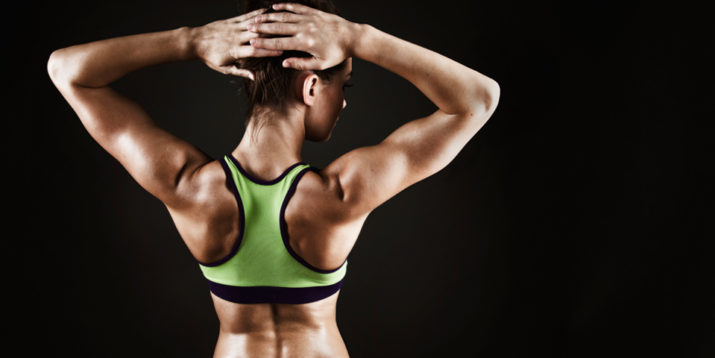
Many people focus on building their “mirror muscles” (think: chest, shoulders, arms, and abs). But to create a well-rounded physique, you don’t want to skimp on back workouts to sculpt the other side of your body, too.
Whether you’re wearing a bathing suit, a tank top, or a backless dress, a well-built back shows the world you’ve got it where it counts.
Physically and aesthetically, there’s no substitute for a strong, muscular back, which is why you should include back workouts into your regularly scheduled routine.
To help you get started, here are some of the best at-home back exercises — weighted and bodyweight — that we know.
1. Dumbbell Bent-Over Row
Appears in: LIIFT MORE – Week 1 Day 3: Back & Triceps
Benefits: This move can help improve posture by challenging the upper and lower back simultaneously.
- Stand with your feet hip- to shoulder-width apart, holding a dumbbell in each hand. Brace your core, push your hips back, bend your knees slightly, and lower your torso until it’s nearly parallel to the floor.
- Let the dumbbells hang at arms length with your palms facing back. Engage your shoulder blades to keep your shoulders pulled back (i.e., don’t hunch). This is the starting position.
- Without moving your torso, and while keeping your elbows tucked and back flat, row the weights to your sides as you squeeze your shoulder blades together.
- Pause, and then lower the weights back to the starting position.
2. Dumbbell Pullover
Benefits: This move is a great way to work your lats, while also strengthening your chest, shoulders, and core.
- Holding a set of dumbbells, lay with your back flat on a bench or stability ball.
- With your feet planted on the ground and your core engaged, extend your arms to the sky, holding the dumbbells together above your chest.
- With a slight bend in your elbows, slowly lower your arms overhead until your biceps reach your ears.
- Slowly bring your arms back to above your chest and repeat.
3. Renegade Row
Appears in: SHIFT SHOP – Strength :25
Benefits: Challenge your upper back and lats while you also work your core and shoulder stabilizers.
- Assume a push-up position with your hands just outside shoulder-width, gripping two light dumbbells or kettlebells. Your feet should be in line with your hands.
- Lift the weight in your right hand off the floor, bringing your hand to the outside of your ribs while keeping your right elbow close to your side. Resist rotation of the body.
- Lower the right weight to the floor and repeat with your left arm, alternating sides.
4. Alternating Row and Lunge
Appears in: Autumn’s BOD Exclusives – Kill Cupcake
Benefits: This move works multiple parts of the upper back (lats, traps, and scapular retractors) with light weights, challenging the muscle fibers responsible for endurance.
- Stand holding two medium to light dumbbells at your sides, palms facing in toward your body.
- Take a big step forward with your left leg, bending it to assume a deep lunge position, keeping your right leg straight.
- Bend forward at your hip, attempting to lay your torso on top of your left thigh. Let your arms hang straight down to the sides of your left leg.
- Bring the dumbbell in your right hand up to the outside of your ribs while keeping your elbow close to your side.
- Reverse the move and repeat with your left arm, alternating sides.
5. Chest-Supported Dumbbell Row
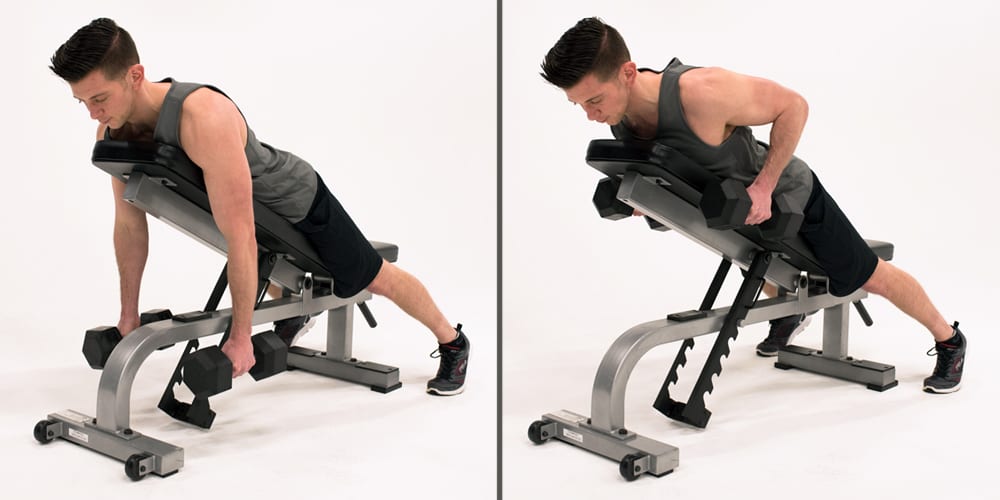
Benefits: By increasing the stability of your body, the chest-supported dumbbell row allows you to use a heavier load than an exercise like the bent-over row.
- Set an incline bench at 45 degrees.
- Grab a pair of dumbbells, and approach the bench with your chest toward the angled pad, then lean onto it. Plant your feet firmly on the floor, and let your arms hang straight down, palms facing each other. This is the starting position.
- Squeeze your shoulder blades together and drive your elbows toward the ceiling, bringing the dumbbells to your ribcage.
- Slowly reverse the move, and repeat for reps.
6. EZ Bar Row
Appears in: Body Beast – Build: Back/Bis
Benefits: This move challenges the large muscles of the upper back to move a heavy load, while the lower back stabilizes and protects the spine.
- Stand upright, feet shoulder-width apart and knees slightly bent, holding an EZ bar in front of your body with a wide grip, palms facing forward.
- Keeping your lower back in its natural arch and your shoulder blades pulled back, hinge forward at the hips until your upper body forms about a 45-degree angle to the floor, and the bar is near your knees.
- Squeeze your shoulder blades together and bend your elbows, pulling the bar up until it contacts your lower abdomen.
- Reverse the move and repeat.
7. Pull-Up
Benefits: This total-body strength builder hones in on the lats, traps, biceps, and core.
- Grip a pull-up bar with an overhand grip with your hands about shoulder-width apart, and hang with your arms fully extended.
- Brace your core and engage your lats to squeeze your shoulder blades together to pull your chest to the bar.
- Pause, and then lower yourself back down until your arms are fully extended again.
Wide-grip variation
For greater focus on your lats, widen your grip beyond shoulder width.
8. Chin-Up
Benefits: This classic move is a great to way to widen and shape your lats, creating that wide V-shape in your upper back.
- Take an underhand grip on a pull-up bar.
- Pull yourself upward until your chin clears the bar, keeping your back straight and core tight as you pull yourself up.
- Lower yourself until your arms straighten, and repeat.
- Too tough? Use a chin-up assist band to make it easier.
9. Close-Grip Oblique Twist
Appears in: INSANITY: THE ASYLUM Volume 2 – Back & 6 Pack
Benefits: This move widens and shapes the lats and it adds an isometric challenge for the upper back and a challenge to obliques and core.
- Take an overhand on a pull-up bar.
- Pull yourself upward until your chin clears the bar, keeping your back straight and core tight as you pull yourself up.
- Holding the top position of the pull-up, lift your knees toward your chest as high as possible.
- Keeping your knees drawn up and squeezed together, contract the obliques on your right side, as if trying to touch the outside of your right hip to your right elbow.
- Repeat on your left side.
- Lower your knees, straighten your arms, return to the starting position, and repeat.
10. Inverted Row
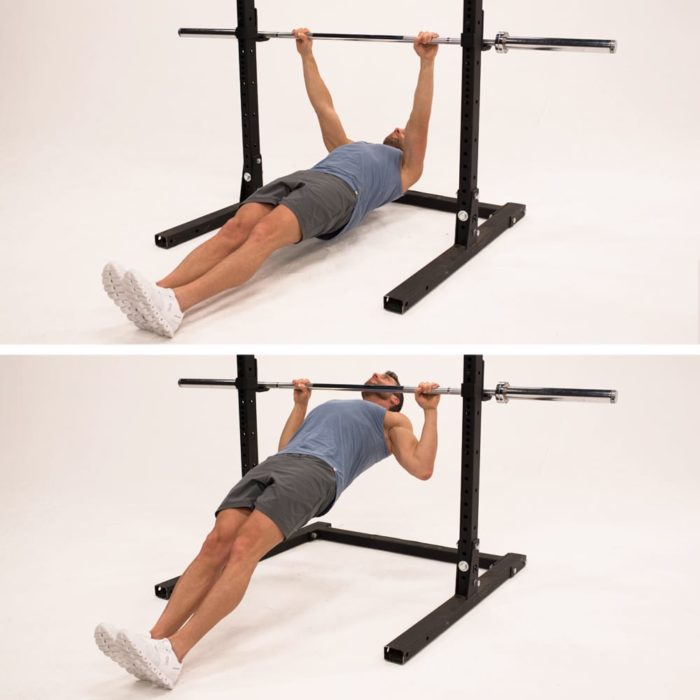
Benefits: The inverted row builds strength in the forearms while also targeting the muscles of the shoulders and upper back, like the rhomboids.
- Secure a barbell in a Smith machine or power rack at waist height, and lie face-up on the floor beneath it. The bar should be lined up directly above your chest and should not move.
- Grab the bar with an overhand grip that’s slightly wider than shoulder width, and hang with your arms fully extended. Your body should form a straight line from your head to your heels, which can be together or hip-width apart.
- Keeping your glutes tight, engage your core and pull your chest to the bar as you keep your shoulders back and squeeze your shoulder blades together.
- Pause, and slowly lower yourself back to the starting position.
11. Lunge Twist Pull
Appears in: 22 Minute Hard Corps – Resistance 2 (as “Punch Pull”)
Benefits: This move works your lats and upper traps in conjunction with your lateral and rear deltoids. The lunge movement also fires up the muscles in your lower body.
- Stand with your feet wider than shoulder-width apart, holding a medium-weight dumbbell in your right hand at shoulder-height.
- Pivot to the left on the balls of your feet, bend both knees into a lunge, and punch toward your left foot on the floor with your right hand.
- As you return to the standing position, place your left hand on the dumbbell and forcefully drive your right elbow backward, pivoting and rotating your torso to the right.
- Repeat on your left side, and do equal reps on both sides.
12. Superman Lat Pull
Appears in: THE 20s – Megan’s Workouts: Pyrashape
Benefits: Using a resistance band, this move strengthens your entire back, from your waistline to the back of your neck.
- Holding a light resistance band, lie on your stomach with your arms extended overhead, chest and arms lifted off the floor, and palms facing down. This is your starting position.
- Keeping both arms straight, trace a half-circle with your right arm, extending it directly out to the side and down toward your right thigh. Your left arm should remain straight overhead.
- Reverse the move, slowly returning to the starting position.
- Repeat with your left arm, and do equal reps on both sides.
13. Single-Arm Row
Benefits: When you perform a single-arm dumbbell row, you can stabilize yourself with the other hand, unlike when you do a dumbbell row with two arms.
Appears in: LIIFT MORE >> Week 1 Day 3: Back & Triceps
- Holding a dumbbell in your right hand, place your other hand on a bench or stability ball in front of you. Step your right leg back keeping it straight, and bend your left leg slightly. Lean your chest forward, keeping your back flat.
- Drive your elbow up, bringing the dumbbell to your ribcage.
- Release your arm down and repeat.
- Do equal reps on both sides.
14. Arm Balance Row
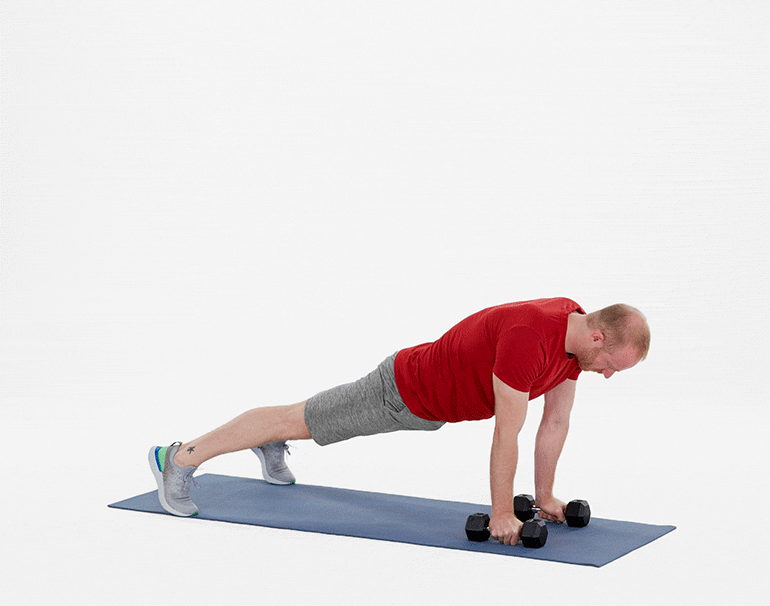
Benefits: This move emphasizes the muscles of the upper back, as well as your shoulders and core.
- Holding a dumbbell in each hand, start in a high plank position with your wrists under your shoulders and your head, hips, and heels in a straight line.
- Pull your right hand to your ribcage then fully extend it to the sky as you twist to the right side. Make sure your arm extends directly over your shoulder and not behind you.
- Return to the high plank position then repeat on the other side.
- Continue alternating, doing equal reps on both sides.
15. Resistance Rows
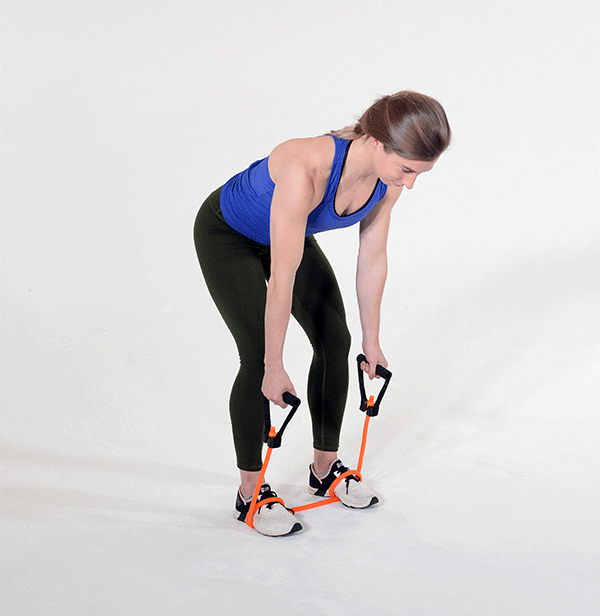
Benefits: Resistance rows are simple but effective, working your entire upper back and deltoids.
- Stand with your feet hip-width apart on the center of a resistance band. Wrap one end around each foot and cross the handles.
- Bend your knees slightly and lean your chest forward slightly, keeping your back straight.
- Keep your core engaged and your back straight as you pull your hands up to your rib cage, squeezing your shoulder blades together at the top.
- Release your arms and repeat.
Back Muscle Anatomy
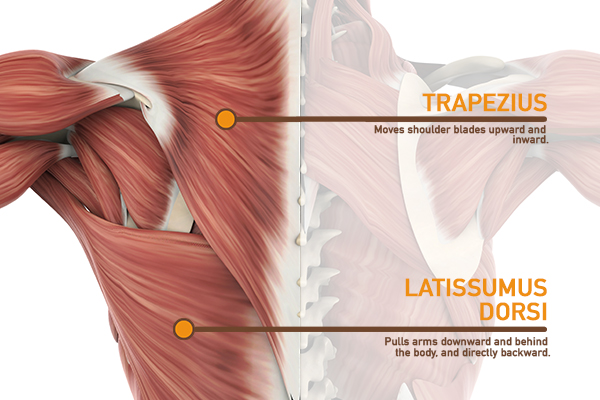
Across the rugged topography of your back are over a dozen different muscles.
Some of them — like the teres minor — stabilize movement at your shoulder girdle; others — including the erector spinae (spinal erectors) — extend your spine, helping to keep you upright.
But the primary focus of back workouts is usually the two largest muscle groups in your back: the trapezius and latissimus dorsi muscles.
Trapezius Anatomy
This is a kite-shaped muscle which extends from the back of your neck to your shoulder blades and down to your mid-back.
Your traps are responsible for moving your shoulder blades upward (as in a shrugging movement) and inward (as in a rowing movement).
When they’re well-developed, the traps keep your posture in check and give your mid-back depth and detail.
Many people, guys especially, focus exclusively on the upper portion of this muscle — the bands of muscle that give gymnasts and football players that thick-necked look.
But that can be a mistake, says Cody Braun, NASM performance enhancement specialist. “When improperly trained, the traps can round your shoulders, which causes a postural dysfunction and a higher likelihood of injury.”
Solve the problem by focusing on mid- and lower-trap exercises instead, using movements that emphasize retracting the shoulder blades.
Latissimus Dorsi Anatomy
Often shortened to “lats,” this fan-shaped muscle originates at your mid- and lower back and attaches to your upper arms.
It pulls your arms downward and behind your body (as in a pull-up movement) and directly backward (as in a rowing movement).
The lats are your primary “pulling” muscles, and when they’re developed, they give your back that unmistakeable “V” shape.
The lats, Braun explains, are often underdeveloped and tight. Strengthening and stretching the muscle is key for good posture and full mobility — particularly in the shoulder joint, he says.
How Do You Build a Bigger Back?
To ensure that you get the most out of your back workouts, it’s essential to consider not just what you do in the gym but what you do outside of it as well.
That includes stress management, sleep, stretching, and diet.
When you’re doing challenging back workouts (or any strength workouts), you need to keep an eye on your protein and calorie intake, making sure you eat enough to help your muscles grow and repair.
For more information on pre- and post-workout supplements, the Beachbody Performance line is a great place to start.
